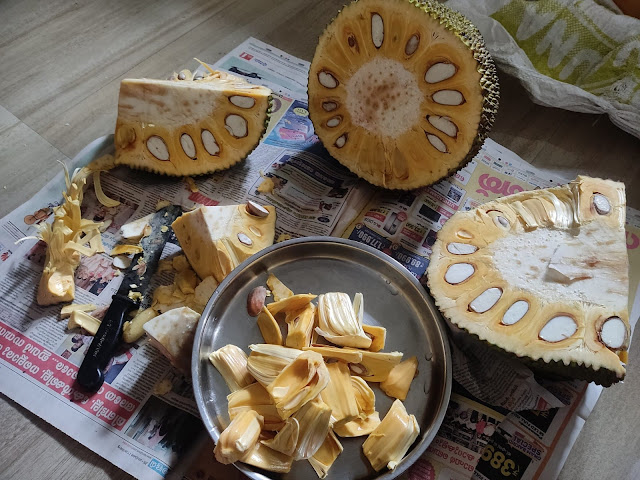21-January-2019
Some youtube videos about Ayurjack jackfruits
20-Sept-2021
Making sure that fruit is ripe on the tree itself...as per one person, only one should be allowed in a bunch, others should be removed so that they can be used to make curry
fruit got in rainy season was not good, better to use them in raw form as vegetable. Now small ones are being formed..
Gave few young jackfruits to neighbours and we also used some. Today sold few of them to a vegetable vendor and it was 7.5Kgs and they took it at 50/- per kg, that was a decent income. Few bigger ones were rotted and lost it, may be because of rain.
Got two more,taste was not upto the mark, I have 2 trees at home and 5 trees at farm, won't be planting any more of this item, wanted to try other varieties like J33 and Combodian Jack
Some time back had visited a farmer called 'Varghese Tharakan' in Trichur who had done a wonderful rain water harvesting in his hilly farm. He had made deep trenches against the slope and directed all the rain water to these trenches. He had planted rubber saplings throughout this farm and also bananas and without any drop of irrigation he could harvest banana and his rubber trees grew well.
Then we hear the news that he cut all the rubber trees and banana and planted a special variety of Jackfruit tree which he named 'Ayurjack'. He discovered this jackfruit tree and it was very tasty and hence propagated it using budding and it gives fruit in 1.5 years. He realised its potential and planted around 1000 jackfruit saplings. Some of his trees have fruited and it looks fascinating and he became famous. He runs a nursery of jackfruit saplings and sells it at rupees 500 onwards and big saplings costs 1500 rupees. Whether this is same as popular Vietnamese early gold jackfruit, not sure?
I visited his farm with my friend and bought two saplings for 600/ rupees each. Even though I am not a fan of budded trees, thought of trying it out. Took around 2x2x2 feet pits and filled with dried cowdung and neem cake (little bit) and then planted it.
Some youtube videos about Ayurjack jackfruits
https://www.youtube.com/watch?v=GyJIglaZF8M
https://www.youtube.com/watch?v=WaV1efggyLI
https://www.youtube.com/watch?v=JLqz7C9rheI
19-January-2019
Ayurjack saplings in my backyard
05-Feb-2019
There are some debate happening whether the Ayur Jack is Vietanamese early or not. Here is some video which explains some findings, it looks like it is Vietnamese early Jack fruit.
https://www.youtube.com/watch?v=WQagnwbNmdo&feature=youtu.be
14-Feb-2019
A recent report which came in news paper about the Ayurjack issue
07-March-2019
29-August-2019
06-October-2019
28-November-2019
https://www.youtube.com/watch?v=WaV1efggyLI
https://www.youtube.com/watch?v=JLqz7C9rheI
19-January-2019
Ayurjack saplings in my backyard
05-Feb-2019
There are some debate happening whether the Ayur Jack is Vietanamese early or not. Here is some video which explains some findings, it looks like it is Vietnamese early Jack fruit.
https://www.youtube.com/watch?v=WQagnwbNmdo&feature=youtu.be
14-Feb-2019
A recent report which came in news paper about the Ayurjack issue
07-March-2019
29-August-2019
06-October-2019
28-November-2019
26-June-2020
After the rains, they are picking up
10-September-2020
One branch fell off, hence cut the top..can see small jackfruit coming up
Jackfruits started growing..3 are there in one bunch
It completed 2 year 8 months..fruits are growing OK, even though small..
Making sure that fruit is ripe on the tree itself...as per one person, only one should be allowed in a bunch, others should be removed so that they can be used to make curry
10-October-2021
---------------------
14-January-2022
Got one more jackfruit, this time harvested it after it was ripe on the tree, smell is very sweet after ripening
18-01-22
Got one more ripened jackfruit...sweet smell was coming and then plucked it, tastes very good
12-July-2022
fruit got in rainy season was not good, better to use them in raw form as vegetable. Now small ones are being formed..
07-October-2022
9-November-2022
06-Feb-2023
Got two more,taste was not upto the mark, I have 2 trees at home and 5 trees at farm, won't be planting any more of this item, wanted to try other varieties like J33 and Combodian Jack




































